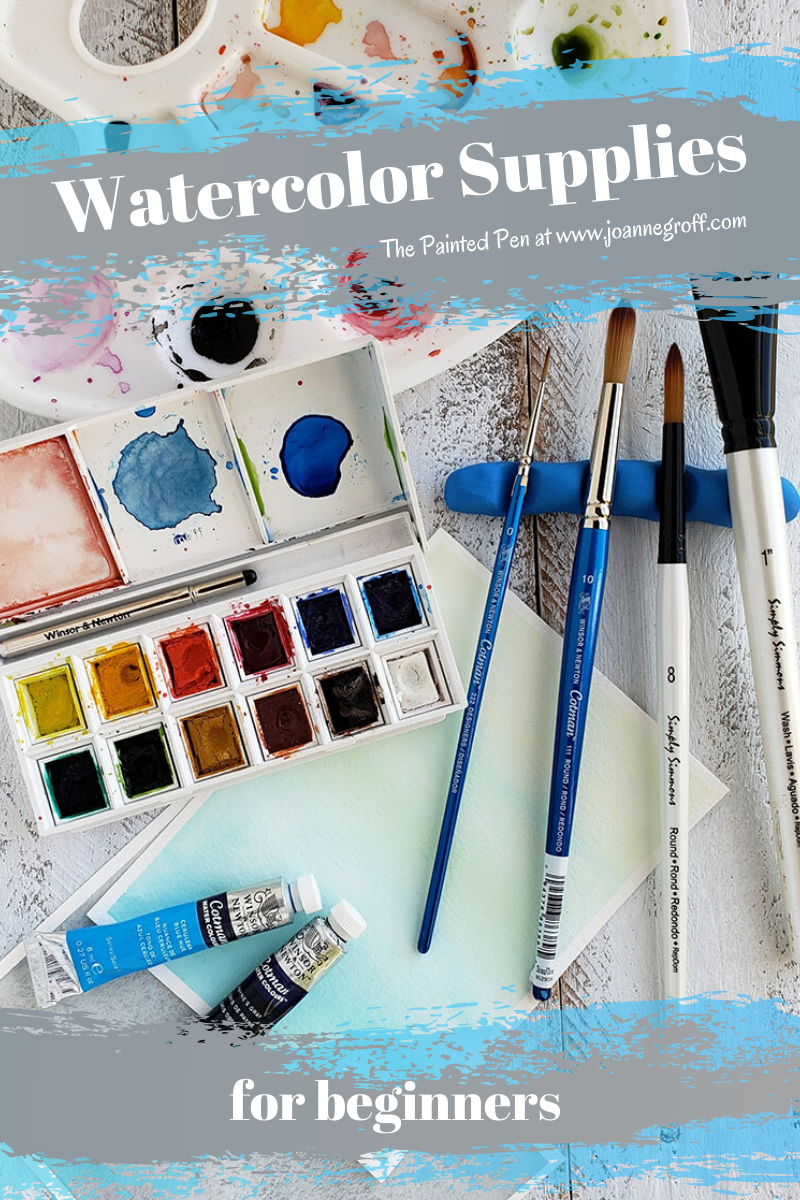
Watercolor Supplies for Beginners
You have an interest in learning to paint with watercolors, but when you look at the art stores online or in person, you find yourself getting lost in the sheer volume of options. What do you need to begin? You don’t want the watercolor set in the kids craft area, but the professional watercolor supplies feel like a huge commitment. And why are there so many different brands? How different can they possibly be?
Today, I’ll give you a list of basic watercolor supplies to set you up as you begin experimenting, and I’ll try to separate the needs from the wants. You can start dabbling with watercolor and have good results without committing to professional grade prices.
I’ll divide this post into three sections: paper, brushes, and paint. I’ll even mention a little about palettes. The paper towels and water are up to you.
When I talk about each section, I’ll give you information on materials and tools that I use and like that are student grade. I believe you can get a good feel for how watercolor works without spending too much as you’re learning. There is no need to stress about whether you are wasting expensive paper or paint while you learn techniques and colors. Now is the time to play and become familiar with the medium without worry.
Paper
XL Canson Watercolor Paper, 9” x 12” 140 lb

This is my go-to watercolor paper for practice. And I would not hesitate to use it as a mock-up for a print that I end up having printed at a professional printer.
It’s acid free and handles water as watercolor paper should, allowing the paint to move and blend on it easily.
However, I always tape this paper to a hard surface before I paint and until it’s completely dry (not just dry to the touch). The taping helps the paper dry flatter.
Don’t …
Use card stock for practice. It soaks up everything in sight and doesn’t let the water and paint do its magic. Instead of sitting on top of the paper for a moment to allow the paint room to move, the water disappears into it immediately.
I don’t mind using Canson watercolor paper to make cards as gifts, but I try to use artist grade paper when I want to sell a painting. The better paper (100% cotton) adds a level of quality that this paper doesn’t.
Brushes

The brushes I reach for the most are Winsor & Newton Cotman brushes or Simply Simmons.
Both brands hold enough water and have a nice spring to the brush, and they produce affordable, student grade brushes (but I use them for all of my watercolor paintings. I haven’t taken the time to explore professional brushes yet).
When I paint with watercolor, I usually pick up one of two kinds of brushes: round or flat. Round brushes work well for most painting. They have a point on the tip for details and create a thicker stroke when you push down on the brush.
Flat brushes make watercolor washes faster and easier.
If I had to pick two brushes to start with (keeping in mind that I usually work on a 5” x 7” or smaller size), I would choose a size 10 and a size 0 round brushes. These brushes give me the ability to easily paint small details or create interesting washes.
Paint

Winsor & Newton Cotman Pocket Box
Much of watercolor paint is preference. Different brands have their own blends of different colors. Some brands have a stickier finish, some brands have a chalkier finish. My favorite watercolors for students or beginners are Winsor & Newton Cotman tubes, but this pocket set is my favorite starter set. They offer a tube starter set too, but it costs a little bit more.
Then, as colors run low, I refill the them from watercolor tubes. I like the tubes of watercolor because they seem to wet easier and smoother.
The difference between these paints and the artist grade paints? The amount of color (pigment) in them. The professional paints have more pigment. But these student grade paints still have good color and will give you a nice understanding of how color in watercolor works.
And … a palette or two!

There are many options for palettes, plastic, ceramic, artistic, plain. You choose. I usually use the palettes that come with my paint sets and the inexpensive one shown in the picture.
I have a couple of inexpensive palettes that I work from. But you could just as easily use a paper plate to get started. Many paint sets also come with a palette lid. Palettes can be artistic or plain, expensive or inexpensive. You choose.
I hope this watercolor supplies list helps you decide what to get started with as you enter the world of watercolors. Or maybe you now have ideas for someone you know who would like to start painting.
Whichever the case … I’m so glad you came. Once you have your supplies, check out some of these tutorials to try them out!
Watercolor Background for Lettering
Tulip Drawing with a Loose Watercolor Blend Technique
Happy creating!

I created a worksheet with this list for your convenience. When you sign up for Blots & Jots email updates, you get access to this printable, Watercolor Supplies List for beginners, in the Resource Library.


